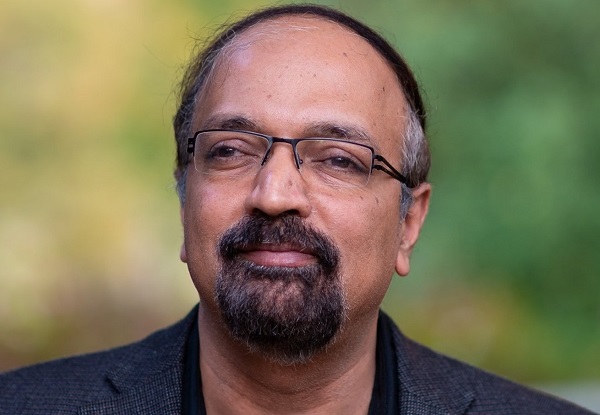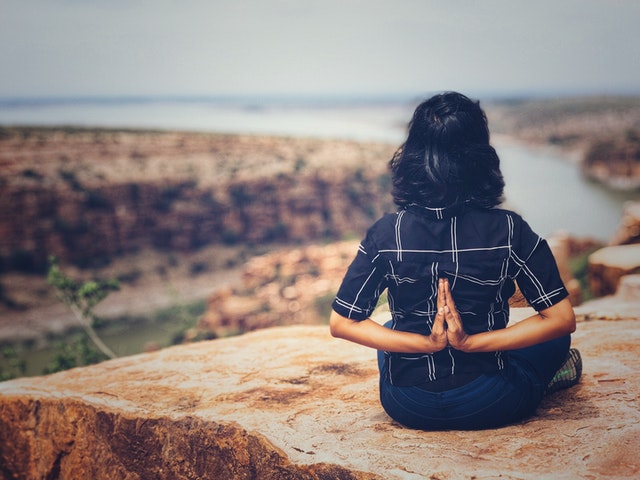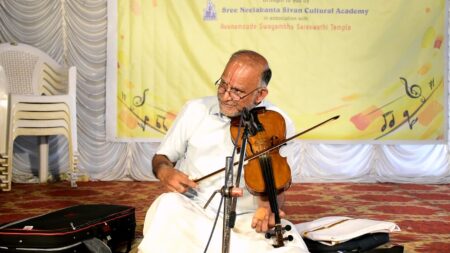Indo-American musician Dr Kanniks Kannikeswaran’s 25-minute video Yog Darshan – The Story of Yoga, traces a comprehensive history of yoga in India through music and visuals, with detailed literary references to yoga found in Sanskrit and Tamil texts.
Yoga might be a billion-dollar industry globally but not much is known about the history, philosophy and all-pervading presence of yoga in India, which is what prompted Dr Kanniks Kannikeswaran to make a musical documentary on it, for a global audience. The musicologist had initially planned a stage production but owing to the pandemic situation, decided on a video instead. “I had for a long thought about a yoga-themed oratorio for Western audiences based on Indian ragas and a symphonic score, much like Shanti – A Journey of Peace or Murasu that I had composed in the past,” he says.
Yog Darshan describes the history of yoga in five chapters, each of which begins with a short narrative in English. The chapters progress in chronological order, from the ancient age to the present, featuring lyrics from texts like Kalidasa’s Kumarasambhavam, Patanjali’s Yoga Sutras and Tirukkural, to name a few.
A speciality of the video is that the maker has referred to texts from across the country. And that, says Kanniks, is one of the main purposes of the video. “On the one hand, yoga is considered to be something modern that has been adapted to suit our times; while on the other, it is believed as something ancient. Then there are yoga studios around the world; people from all over the world teaching their interpretation of the yoga sutras, in many cases with their pronunciation. Lost in between is the presence of yoga in works that have been written over the past 2000 years; from the references to the asanas in Silappathikaram to Dikshitar’s references to Yama Niyam Adi Ashtanga Yoga Vihite 200 years ago. Then there is the litany of asanas described by Tirumular, the 15-fold ways to the realisation of oneness in the words of Adi Sankara and more.”

The research process
It all started when Kanniks set a few verses of Tirumular to music some years back, following which he decided to translate a few for a research publication. The research behind the publication served as a major part of the foundation of the music video, owing to which there are numerous references to yoga in Tamil texts. “Tirumandiram has several verses on ashtanga yoga. I have compared them to the description of ashtanga in Patanjali’s Yoga Sutras. I used a few lines from Sivajnana Siddhiyar in the context of ashtanga yoga. I have also used a verse from Kuthambai Siddhar in a folk tune in the raga senjurutti.
Kanniks says that he was amazed by the pan-Indian nature of yoga which he found in the various verses he came across during his research. “There are sannidhis to Patanjali in Tamil Nadu, the Vijnana Bhairava tantra and the Shiva Sutras from Kashmir, the Gorakhpur – Gorakhanatha – Hampi yoga sculptures and more. The Saiva Siddhanta tradition and the Tamil works that acknowledge yoga, the presence of ajapa – the silent dance of breath – in Tirumular’s work, the continuity in the works of the Siddhas, ajapa in Gheranda Samhita and again in Dikshitar, the ritual dance enacted in Tiruvarur and even our own Tiruvanmyur, it’s exhilarating.”
The music

The creator has taken care to choose singers from the same regions the verses are associated with. The video has 5 chapters. The invocation is in the raga Yaman, featuring lyrics from Kalidasa’s Kumarasambhavam. The second chapter begins with raga Bauli with a Tirukkural verse and the Tirumandiram is set in Mohanam. Ragas like Durga, Gambhira Nattai, Udaya Ravichandrika, Desh, Sudh Sarang, Jog and so on were used in Yog Darshan.

Tirumalar’s verses have been sung by Sai Sisters, Adisankara’s words by Vasudev Krishna, Vijnana Bhairava tantra by a Kashmiri Pundit singer Rahul Wanchoo in raga Bhairava. “The yoga sutras naturally fell in raga jog. Vivek Sadasivam has sung the lines from Viveka Martanda while Kruti Bhatt recorded the line for Hampi from Dharmasthala. My daughter Vidita has also sung a few lines. Balraj and Vanraj Sastri from Ahmedabad sang a number of the choral segments and some lead segments while playback singer Abhay Jodhpurkar sang the invocatory passage a line from the Yoga Yajnavalkya,” he says.
Music producer Sai Shravanam has done the mixing which was presented by the Hindu University of America during the International Yoga Week in June 2021
Coming up next
Kanniks is planning to bring our a short musical video on naada yoga next, something musicians are aware of, he says. “When we use the word yoga, the first thing that comes to one’s mind is a vrikshasana or a head-stand. But we all know that yoga is more than that. We all relate to that Omkara, that cosmic energy of manifestation — that oneness; that one that we worship and adore advitiyam upasmahe.




